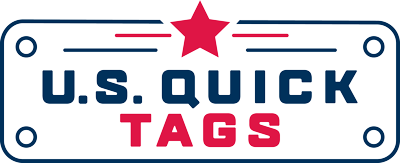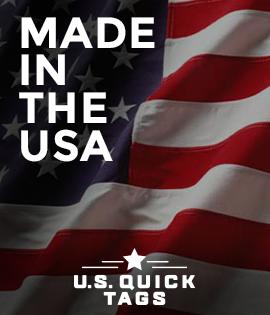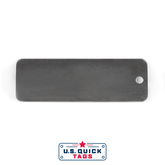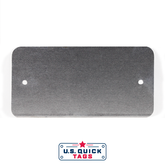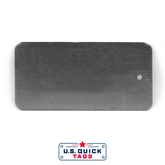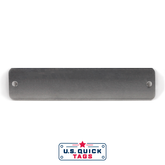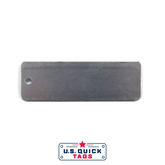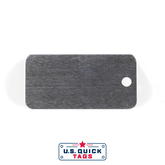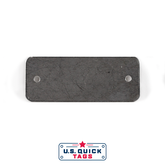Material: Aluminum
Tag Thickness: .025”
Tag Height: 1”
Tag Length: 1”
Hole Location from Center to edge: 0.5”
Hole Size: 0.263"
Blank Metal Survey Tags: Everything You Need to Know
Are you trying to decide on the best blank metal survey tags for your project? Look no further. This guide explores how to choose tough tags tailored to your precise needs. We’ll walk through identifying the right material, size, and shape for your surveying or asset-tracking project, ensuring your tags meet both practical demands and project-specific requirements.
Three Main Considerations for Blank Metal Survey Tags
- Blank metal survey tags are essential for marking locations and identifying assets and are customizable to meet project-specific needs, offering durability and adaptability for construction and environmental studies.
- Material selection for metal survey tags includes aluminum for its lightweight and corrosion resistance, stainless steel for extreme durability, and brass for aesthetic appeal, each suited for different environmental conditions and applications.
- The marking of metal survey tags can be done using techniques like stamping, etching, and dot peening, with each method offering varying levels of durability and customization, influencing the tag’s lifespan and visibility.
Blank Metal Survey Tags: Purpose and Benefits
When marking specific locations or points of interest, identifying assets and equipment, or catering to unique specifications, nothing beats the versatility of blank metal survey tags. These tags are essential in construction, simplifying identifying assets, marking locations, and tracking equipment across project sites.
The beauty of blank metal tags lies in their customizability. Completely custom metal tags can be designed to cater to unique project specifications and requirements. In other words, these tags, including blank tags, can be tailored to meet your specific needs, making them a go-to choice for many applications.
Marking Locations
Imagine a land surveyor marking and identifying specific sites or points of interest. The perfect companion for this job is a blank metal survey tag, designed in a washer-like shape to ease attachment to various surfaces. These tags are usually secured with a nail, providing a permanent mark that helps professionals return to the same spot, even after many years.
But what if the environment is densely vegetated or requires long-distance visibility? The solution lies in attaching brightly colored flags or tapes to the survey tags, enhancing their visibility. These tags prove instrumental in environmental studies, marking locations such as sample collection points for water and soil testing.
Asset Identification
Picture a bustling construction site with countless pieces of machinery and tools. Keeping track of each asset could be a Herculean task without a reliable labeling system. Enter the metal asset tags, providing durable labeling to prevent theft and loss.
These tags are customizable with barcodes and serial numbers, simplifying asset tracking and management. They are indispensable in many scenarios, including:
- Facilitating efficient control of inventory in SAP installations
- Marking trees for conservation efforts
- Incorporating data such as license numbers and company information for identification purposes
Now, that’s what we call a versatile labeling solution!
Customization Possibilities
One of the standout features of metal survey tags is the limitless customization possibilities they offer. Whether you’re looking for specific hole sizes, personalized designs including company logos, or unique fonts, these tags can be shaped to conform to your specific needs or regulations.
Anodized aluminum tags have several advantages:
- They can be color-coded to represent different properties or company branding
- They offer high contrast for better readability
- They can be paired with diverse fastening options like nails, links, rings, rivets, ball chains, and wire attachments to suit installation needs on various surfaces or objects.
For industrial uses where standard customization options are insufficient for most applications, manufacturers are willing to create custom solutions to meet specific requirements. The sky’s the limit when it comes to customization!
Material Selection: Comparing Aluminum, Stainless Steel, and Brass
When selecting the right material for your blank metal survey tags, you’ve got three prime candidates: aluminum, stainless steel, and brass. Each of these materials offers different gauges and finishes for customization and heavy-duty use in harsh environments.
For stamped tags, the following materials are commonly used:
- Aluminum: provides durability and a clear indented marking, is lightweight, cost-effective, and offers ease of customization
- Stainless steel: provides durability and a clear indented marking
- Brass: favored for non-ferrous applications such as in valve tags or mining industries
Among these options, aluminum and plastic tags are popular due to their lightweight, cost-effectiveness, and ease of customization.
On the other hand, metal tags are ideal for long-term environmental monitoring projects because they can withstand harsh conditions and remain legible over decades.
Aluminum
Why might aluminum be your material of choice for tag creation? For starters, aluminum tags are lightweight, making them easy to handle and attach to various assets without adding significant weight. Plus, they’re corrosion-resistant and can withstand exposure to chemicals and solvents, enhancing their durability.
Furthermore, aluminum tags are considered affordable while providing a sturdy and reliable solution for tagging needs. Their anodization layer is sealed to meet military specifications, ensuring they resist prolonged exposure to challenging substances like salt water, fuels, and acids. Given their thinness and use of high-performance adhesives, anodized aluminum tags can securely adhere to uneven and curved surfaces, making the application flexible and reliable in different scenarios.
Stainless Steel
If durability and weather resistance are at the top of your list, stainless steel tags may be the perfect fit. Recognized for their robust nature, these tags are suitable for long-term use, even in harsh environments.
Stainless steel is often chosen for environments that require extreme durability, such as high-temperature settings or areas with potential exposure to corrosive materials. Due to their robust nature, stainless steel tags maintain the integrity of etched information over an extended period, resisting alteration.
Brass
For those seeking a combination of aesthetics and functionality, brass tags offer a compelling choice. These tags offer classic good looks alongside corrosion resistance, with the ability to be finished for either decorative or industrial purposes.
When engraved, brass tags provide excellent legibility due to the contrast between the dark brown to black engraving and the bright brass color. However, they are heavier than some alternatives and may not be suitable for applications where weight is critical.
While brass tags are highly durable and maintain legibility over time, they have a lower strength than materials like stainless steel. They may not be ideal for high-tensile strength applications.
Choosing the Right Tag Shape and Size
Choosing the right tag shape and size may seem like a minor detail, but it can significantly impact the tag’s visibility and the amount of information it can contain. You have many options, whether it’s standard shapes, custom shapes, or size considerations.
Standard Shapes
Standard shapes for blank metal survey tags include round, square, and rectangular options. Round tags are a popular choice for general-purpose applications, offering a simple shape that can fit in most environments. On the other hand, square-shaped tags provide a symmetric design that can enhance visibility and alignment.
If your project requires more surface area for information, rectangular tags are your go-to choice. Their elongated shape accommodates more text or symbols. Standard metal survey tags are produced using high-speed presses for efficiency and to compete with overseas suppliers, ensuring both quality and affordability.
Custom Shapes
Beyond standard shapes, custom shapes offer a whole new world of possibilities. Custom metal survey tags can suit various industries, including aerospace, construction, and utilities, meeting different state regulations and guidelines.
Whether it’s about accommodating various nail types or meeting state-specific regulations and guidelines regarding tag sizes, shapes, and the information required to be marked, custom shapes prove their worth. With the ability to create survey tags with any hole size necessary, including pre-drilled holes, these tags showcase the adaptability of custom shapes to specific surveying needs.
Size Considerations
Choosing the right size for your metal tag involves balancing visibility and the amount of information required on the tag. To remain easily locatable, survey tags need to stand out against ground cover like weeds or be large enough for situations where tags must be identifiable from a distance.
At the same time, the size should accommodate necessary information such as license numbers and company details. The final usage of the metal survey tags and the marking process should guide the selection of tag thickness to avoid issues such as warping, ensuring both functionality and legibility.
Marking Techniques for Blank Metal Survey Tags
The marking technique for your blank metal survey tags can significantly impact their durability and ease of marking. The three major marking techniques include stamping, and etching each offering different levels of durability and customization.
Stamping
Stamping involves using a press to create an indented and durable impression on metal survey tags, making it a suitable technique for long-term legibility. This process can also include ink filling to enhance visibility.
Automating the stamping process allows for high-volume production, swiftly creating numerous tags with consistent quality, making it a cost-effective choice for producing serialized data tags. It’s no wonder that stamped metal tags are expected to last over 20 years outdoors, even under rigorous conditions.
Etching
Etching offers a high degree of customization but may offer less durability than stamping. Laser etching employs a high-power laser to inscribe lasting designs into the surface of metal tags, allowing for the inclusion of images, text, or serial numbers.
Chemical etching selectively dissolves the metal substrate using an acid bath, applied only to designated areas to create the required image. While more durable than screen printing, laser-etched markings on metal typically have a lifespan of around 5-10 years.
Dot Peening
Dot peening involves using a pneumatically driven stylus to create a series of small, indented dots on the metal surface. These dots form patterns or alphanumeric characters that provide clear and durable identification. Dot peening is known for its versatility; it is used on various metal materials, including stainless steel, aluminum, brass, and more.
One of the critical advantages of dot peening is its ability to create deep and permanent marks resistant to wear, corrosion, and fading. It is an ideal solution for applications where durability is crucial, such as in the aerospace, automotive, oil and gas, and manufacturing industries.
Industry Applications of Blank Metal Survey Tags
Blank metal survey tags are not just versatile; they are also widely used across various industries. These tags, from construction and utilities to environmental studies, are essential for marking locations, identifying assets, and tracking data.
Construction
In the construction industry, blank metal survey tags play a pivotal role. With bar codes, these tags provide a methodical approach to inventory management in construction projects, identifying skids, industrial racking, and shelving within a construction site.
Bar code tags improve operational efficiency by simplifying locating and identifying various machinery and assets. It’s a practical solution to managing the complexity of a construction site.
Utilities
In the realm of utilities, blank metal survey tags prove their worth by marking and identifying infrastructure components and critical points. These tags are chosen for their ability to withstand harsh conditions, such as:
- high temperatures
- acids
- radiation
- corrosives
which are often present in these work environments.
Electrical companies, for instance, utilize these tags to mark and identify utility poles, making maintenance and service tracking a breeze. They also contribute to the labeling and organization of various cables and wires, ensuring a systematic approach to managing complex networks.
Environmental Studies
In environmental studies, blank metal survey tags track and document crucial data. Debossable and annealed aluminum tags over a heavy cardstock core are commonly used in these studies.
Debossable aluminum tags, even if the ink is washed off, leave an indented impression that ensures the information remains legible over time. Annealed aluminum tags over a heavy cardstock core are designed explicitly for tracking periodic inspection records, making them an effective data management tool in environmental studies.
Summary
Blank metal survey tags are invaluable assets in the world of object identification and location marking. Their versatility, durability, and customizability make them ideal for various industrial applications, from construction and utilities to environmental studies.
Whether you’re considering the right material, size, shape, or marking technique, these tags offer myriad options to meet your specific needs. They’re not just tags but essential tools that make our world more organized, manageable, and efficient.
Frequently Asked Questions
What are the primary purposes of blank metal survey tags?
The main purposes of blank metal survey tags are to mark specific locations or points of interest, identify assets and equipment, and offer customization possibilities.
What materials are commonly used for blank metal survey tags?
The most common materials used for blank metal survey tags are aluminum, stainless steel, and brass, each with varying levels of durability, customization, and cost-effectiveness. Choose the material that best suits your specific needs.
What are the standard shapes of metal survey tags?
The standard shapes for blank metal survey tags include round, square, and rectangular options. These shapes are commonly used for various surveying purposes.
What are the different marking techniques for blank metal survey tags?
The primary marking techniques for blank metal survey tags are stamping, etching, and dot peening, each with varying levels of durability and customization. Consider the specific needs of your survey tags to choose the most suitable marking technique.
What industries commonly use blank metal survey tags?
Blank metal survey tags are commonly used in construction, utilities, and environmental studies to mark locations, identify assets, and track data.
